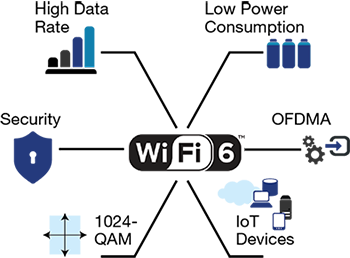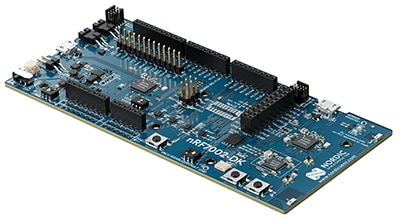A look at the next generation of Wi-Fi and its advantages in connecting the Internet of Things.
Connecting the Internet of Things
With the rapid growth of the Internet of Things (IoT), where everyday objects are being connected to the Internet, reliable and efficient wireless connectivity is becoming increasingly important. The growth of IoT demands fast, reliable, and secure Wi-Fi in homes, businesses, and industrial environments. Previous generations of Wi-Fi have some limitations in the IoT space in terms of interference, response time, and power consumption. Wi-Fi 6 is the latest generation of the Wi-Fi standard, providing key technical enhancements that make it more suitable for IoT applications. With improvements in speed, capacity, and performance, Wi-Fi 6 has the potential to improve both the functionality and efficiency of IoT devices.
Limitations of Previous Versions of Wi-Fi for IoT
The previous versions of Wi-Fi (e.g., 802.11a/b/g/n) have limitations that make them unsuitable for rapidly evolving IoT applications. Two of the most prominent limitations have been interference and power consumption.
- Power Consumption: IoT devices are often battery-powered, and Wi-Fi connectivity can drain battery life. The earlier versions of Wi-Fi were designed mainly for high-speed data transfer and focused little on power efficiency. IoT devices connected to these networks would consume excessive power, leading to reduced functionality and shorter battery life.
- Wireless Interference: IoT devices frequently operate in environments with high wireless interference. This interference may occur due to the presence of other Wi-Fi networks and other wireless technologies, such as Bluetooth and Zigbee. Unfortunately, the earlier versions of Wi-Fi were not optimized for interference mitigation, resulting in degraded performance and reliability of IoT devices.
Wi-Fi 6 solves these challenges by optimizing power efficiency and interference management.
Key Technical Enhancements in Wi-Fi 6 for IoT
Wi-Fi 6 brings significant technical enhancements to the Internet of Things (IoT). It improves IoT connectivity in many ways:
- Higher Data Rates: Wi-Fi 6 can provide data rates up to three times faster than its predecessor, Wi-Fi 5, reaching up to 9.6 Gbps. The faster data rates enable its use in critical applications that require real-time monitoring.
- Reduced Power Consumption: Wi-Fi 6 introduces a new feature called "target wake time" (TWT), which allows devices to schedule when they wake up to send or receive data. TWT reduces their time in an active state and ultimately saves power. TWT's scheduling mechanism lets the device and access point coordinate when data is sent and received. The access point sends a message to the device indicating when it can go to sleep and when it needs to wake up to receive data. The device then sets its timer to wake up at the appropriate time. TWT is an important feature for IoT applications deployed in remote or hard-to-reach locations.
- Better Use of Channel Bandwidth: Wi-Fi 6 has an orthogonal frequency-division multiple access (OFDMA) feature that allows multiple devices to send and receive data simultaneously over a single channel. OFDMA divides the channel into smaller sub-channels, enabling more devices to use the network without slowing it down or causing congestion. OFDMA is especially useful for high-bandwidth applications, such as video streaming.
- Higher Throughput than Other Short-Range Wireless Solutions: Wi-Fi 6 provides higher throughput than other short-range wireless options. Higher throughput makes it possible to perform high-bandwidth applications such as real-time HD video streaming, virtual reality, and augmented reality. This is achieved through advances such as MU-MIMO (multi-user, multiple input, multiple output) and 1024-QAM (quadrature amplitude modulation). MU-MIMO lets multiple devices communicate with the Wi-Fi router simultaneously without interfering with each other, improving throughput and network efficiency. More devices can be supported on the network without causing slowdowns or congestion.
- Improved Security: Wi-Fi 6 has many security enhancements, including WPA3 encryption. This makes it harder for unauthorized users to access IoT devices or data on the network.
- Compatibility with More Networks: Supporting Wi-Fi 6, with backwards compatibility for older Wi-Fi versions, enables a device to work with the widest range of networks. If only one device on a network does not support Wi-Fi 6, that device would slow down the entire system by forcing the entire network to run on an older Wi-Fi version.
- Future-proofing: Many networks will be upgraded to Wi-Fi 6. Devices that don’t support it may not be compatible.

Figure 1: Benefits of Wi-Fi 6
Internet of Things
Shop our wide variety of IoT Semiconductors by Nordic Semiconductor.
Don't forget to join our discussion.
IoT Solutions with the Nordic nRF7002 Wi-Fi 6 Companion IC
The Nordic nRF7002 Wi-Fi 6 Companion IC is designed to simplify the process of creating IoT devices with Wi-Fi connectivity. The nRF7002 supports the latest Wi-Fi 6 standard and offers faster data transfer speeds, improved network efficiency, and better performance in congested environments. In addition, the nRF7002 features low power consumption and advanced power management, which can increase the battery life of IoT devices.
The nRF7002 has advanced security features such as WPA3 encryption, making it good for applications that require secure data transmissions, such as smart home devices and medical sensors.
The nRF7002 integrates directly with Nordic's nRF52840 , nRF5340 , and nRF91 Series devices. When used together, the nRF7002 can serve as a high-performance radio front-end for the nRF5340 or nRF52840, which integrate a BLE radio and are capable of supporting wireless protocols such as Thread and Bluetooth Mesh. The nRF9160 SiP enables GPS/GNSS and cellular locationing.
By combining the nRF7002 with the nRF5340 or nRF52840 and nRF9160 SiP, designers can take advantage of the high-performance radio capabilities of the nRF7002 to improve the reliability and communication range of the integrated wireless protocol.
The nRF7002 DK shown in figure 2 is the development kit for the nRF7002 Wi-Fi 6 Companion IC providing all the necessary components on a single board. It features an nRF5340 multiprotocol System-on-Chip (SoC) as a host processor for the nRF7002.

Figure 2: Nordic nRF7002 DK
Buy now
Developers can integrate the nRF7002 into their IoT devices using the Nordic nRF Connect SDK. This SDK supports a wide range of development tools. It also includes example code and reference designs to help developers get started.
Check out the nRF7002 DK RoadTest!
Summing Up: Wi-Fi 6 and the Internet of Things
in partnership with

Wi-Fi 6 is a significant step forward in addressing the limitations of previous Wi-Fi versions, and is a more viable option for IoT applications. As the IoT continues to grow and evolve, it is essential to have a wireless connectivity solution that can meet the demands of this rapidly expanding market. The Nordic nRF7002 Wi-Fi 6 Companion IC, in combination with with Nordic’s existing products, can provide seamless connectivity and overcome the challenges associated with IoT connectivity.
What new IoT devices and applications do you think are possible with more advanced connectivity?
Please tell us in the Comments section below.

-

dougw
-
Cancel
-
Vote Up
0
Vote Down
-
-
Sign in to reply
-
More
-
Cancel
Comment-

dougw
-
Cancel
-
Vote Up
0
Vote Down
-
-
Sign in to reply
-
More
-
Cancel
Children